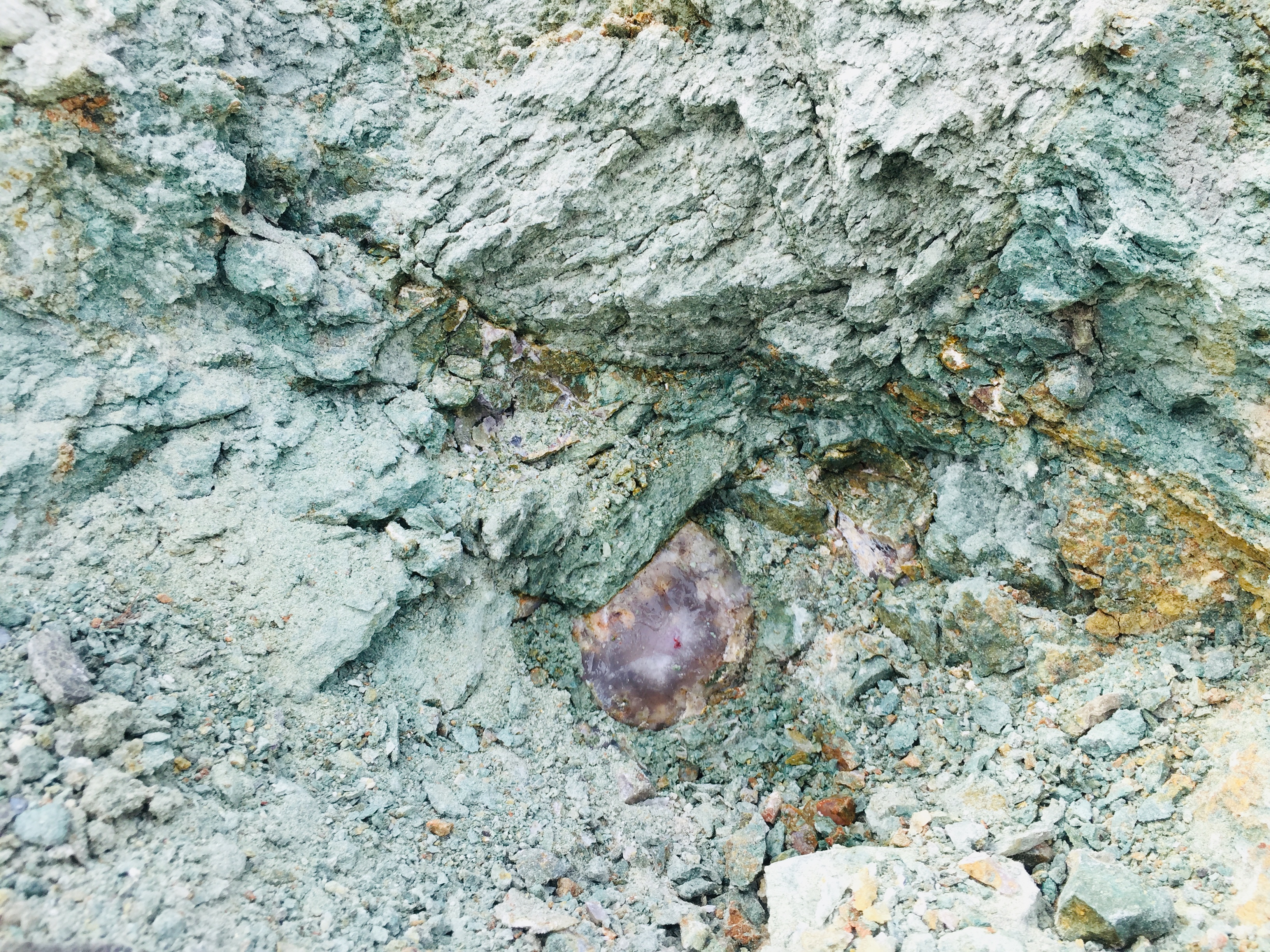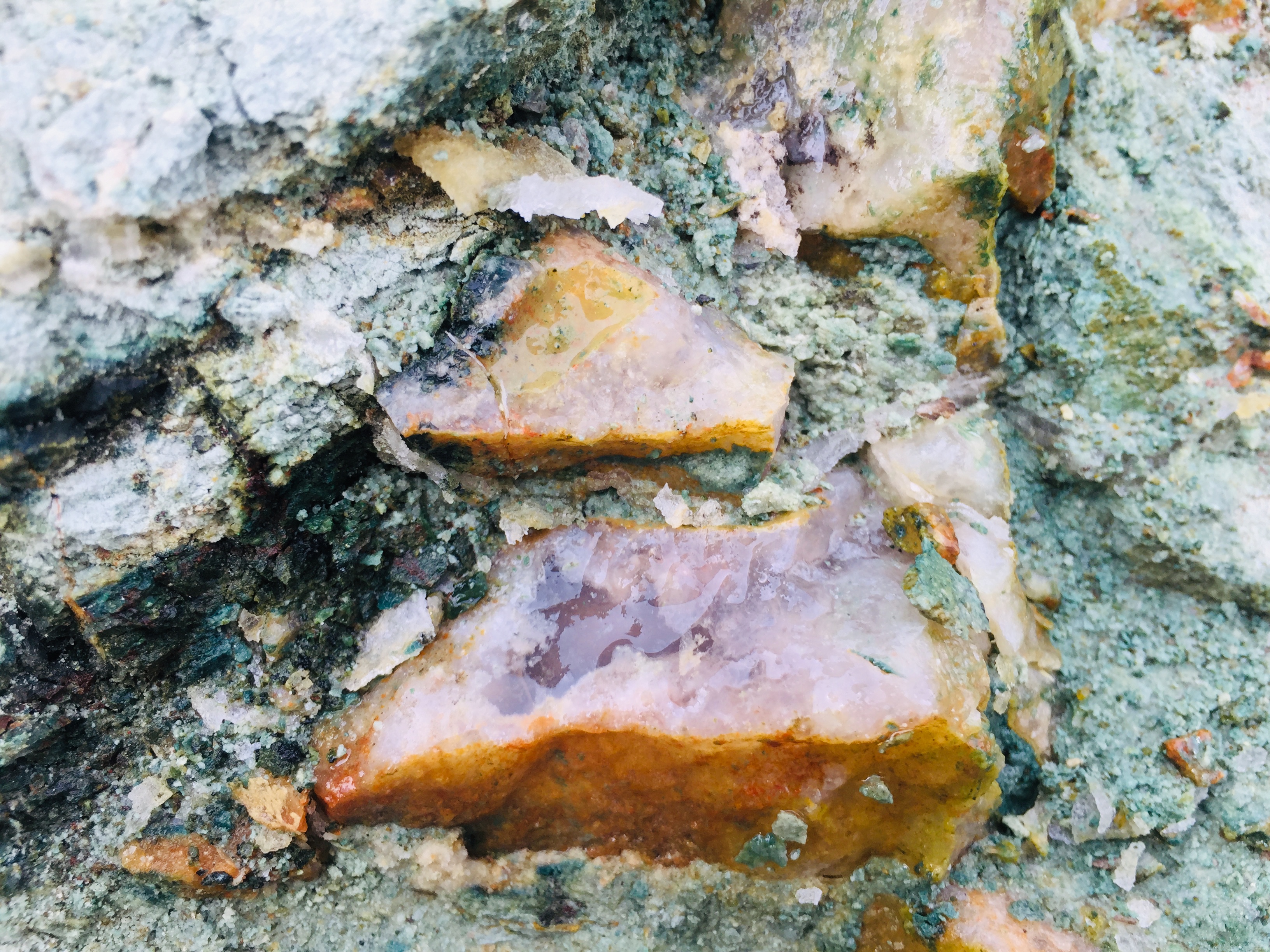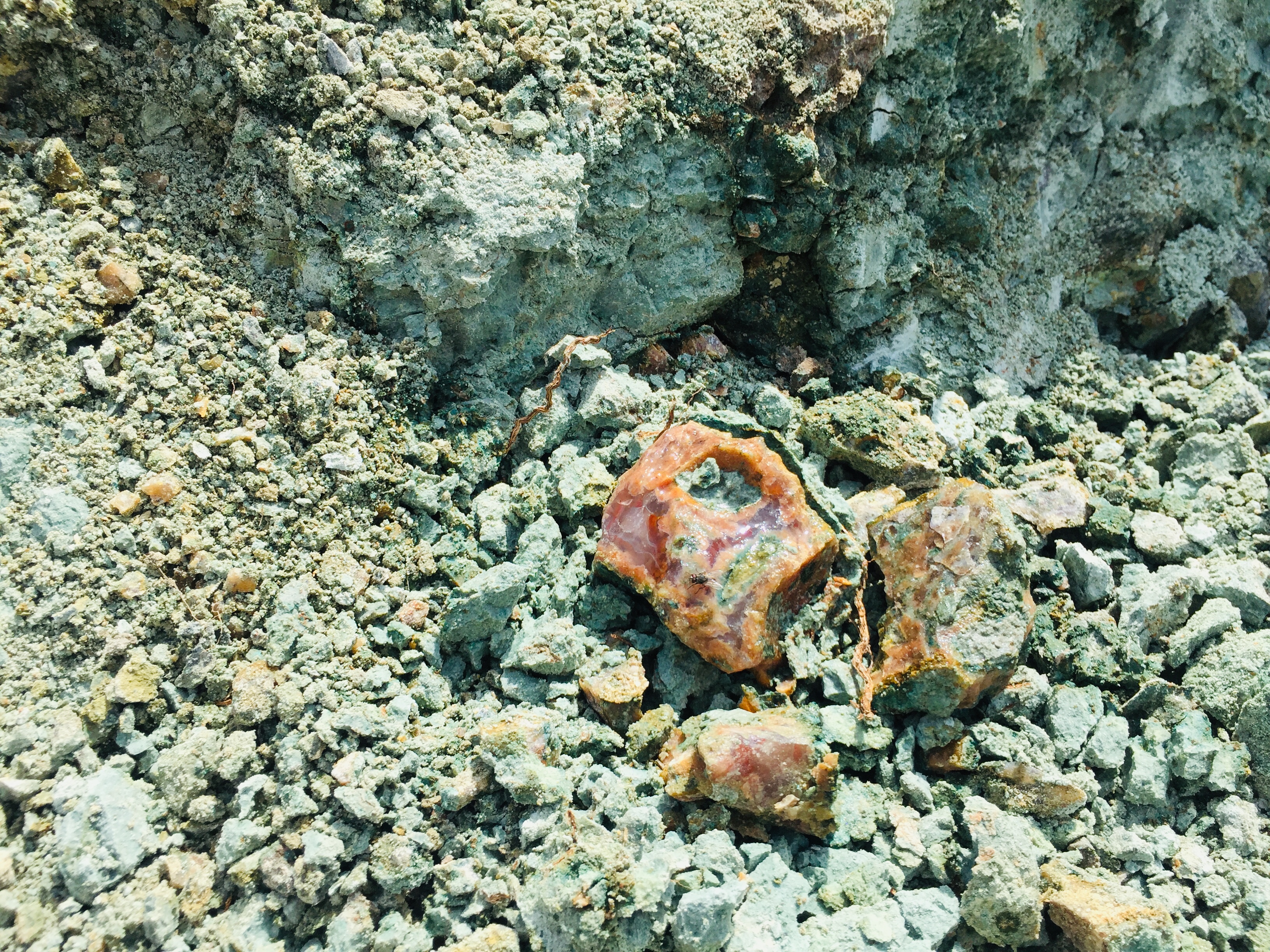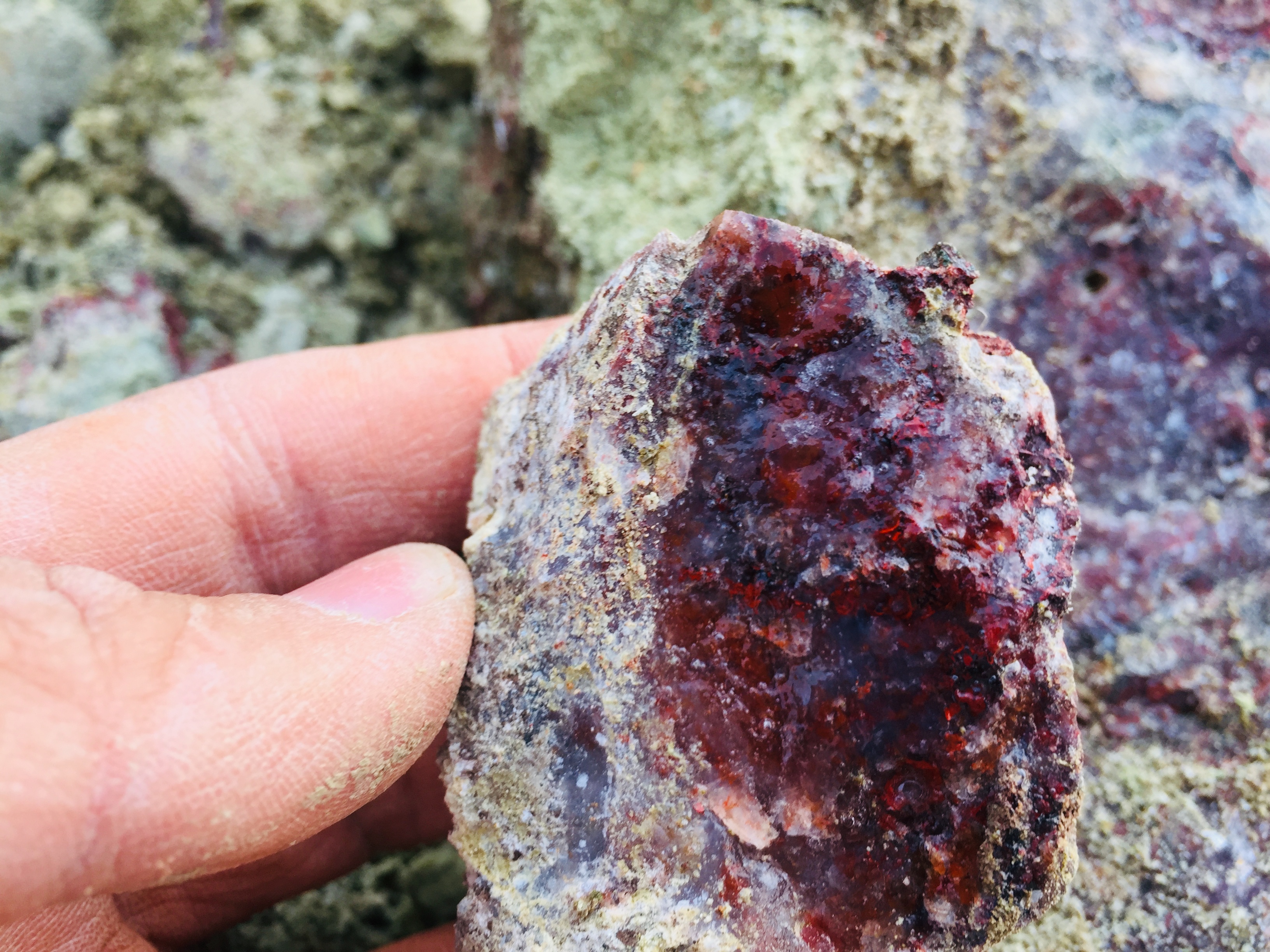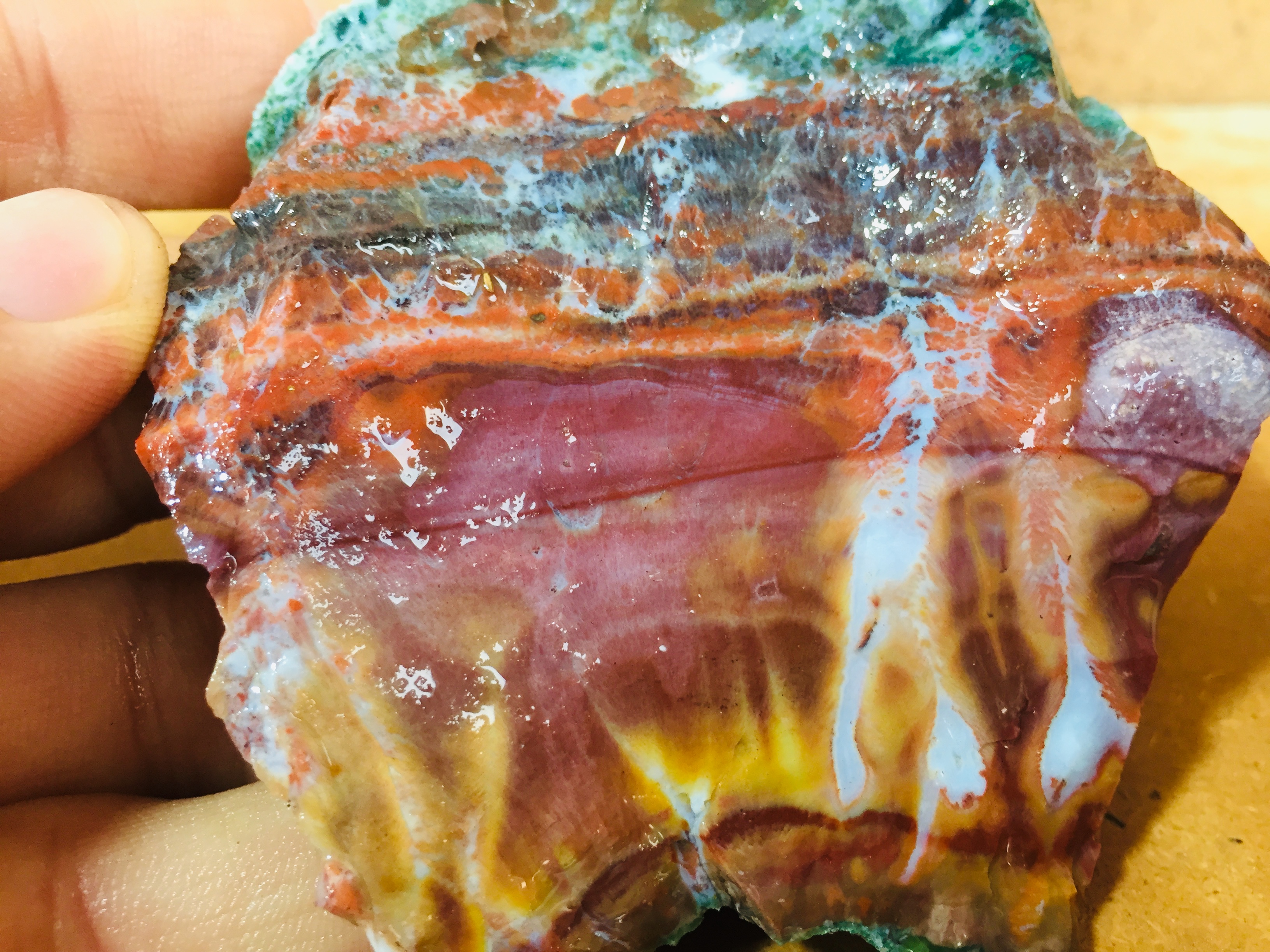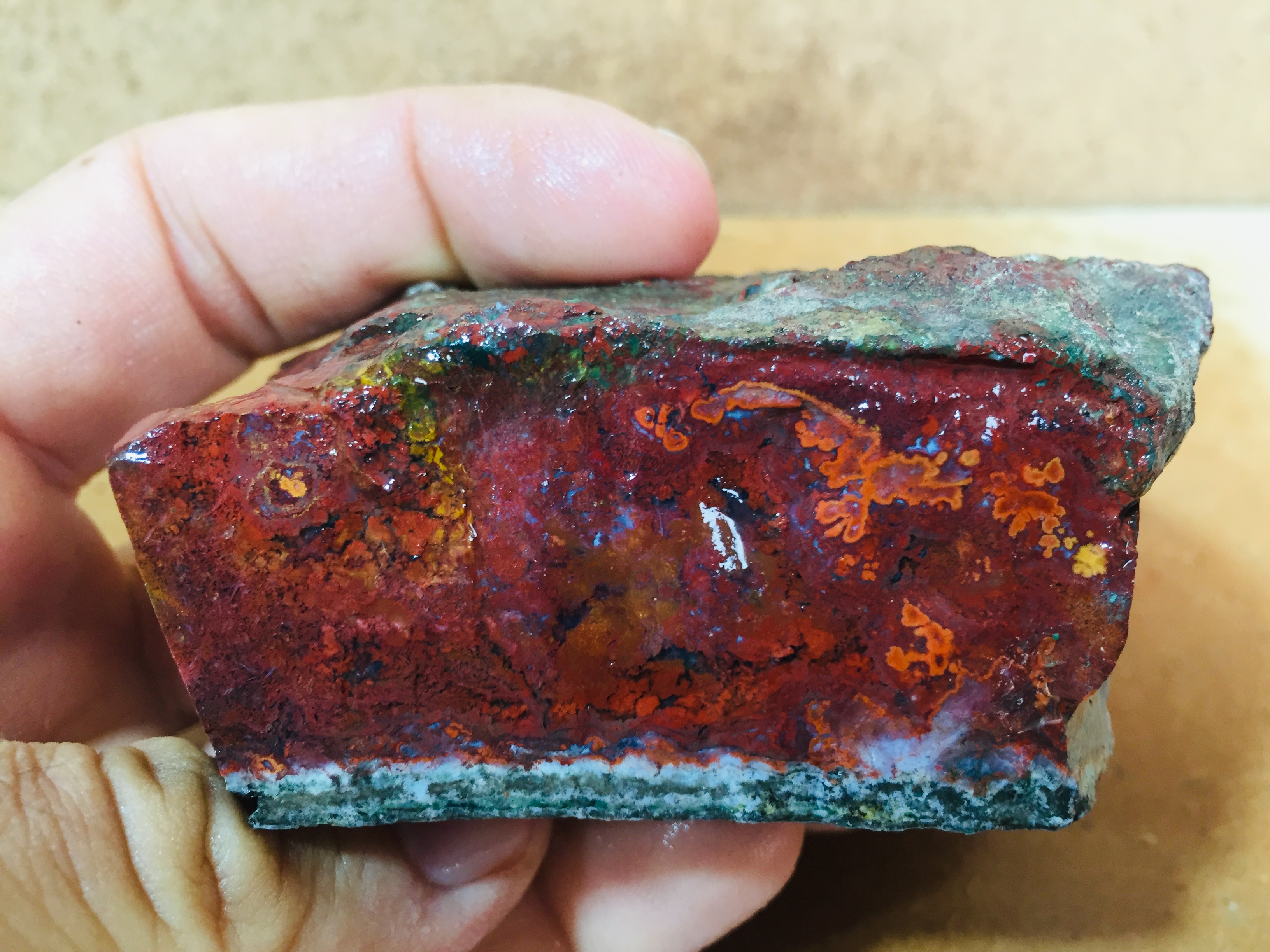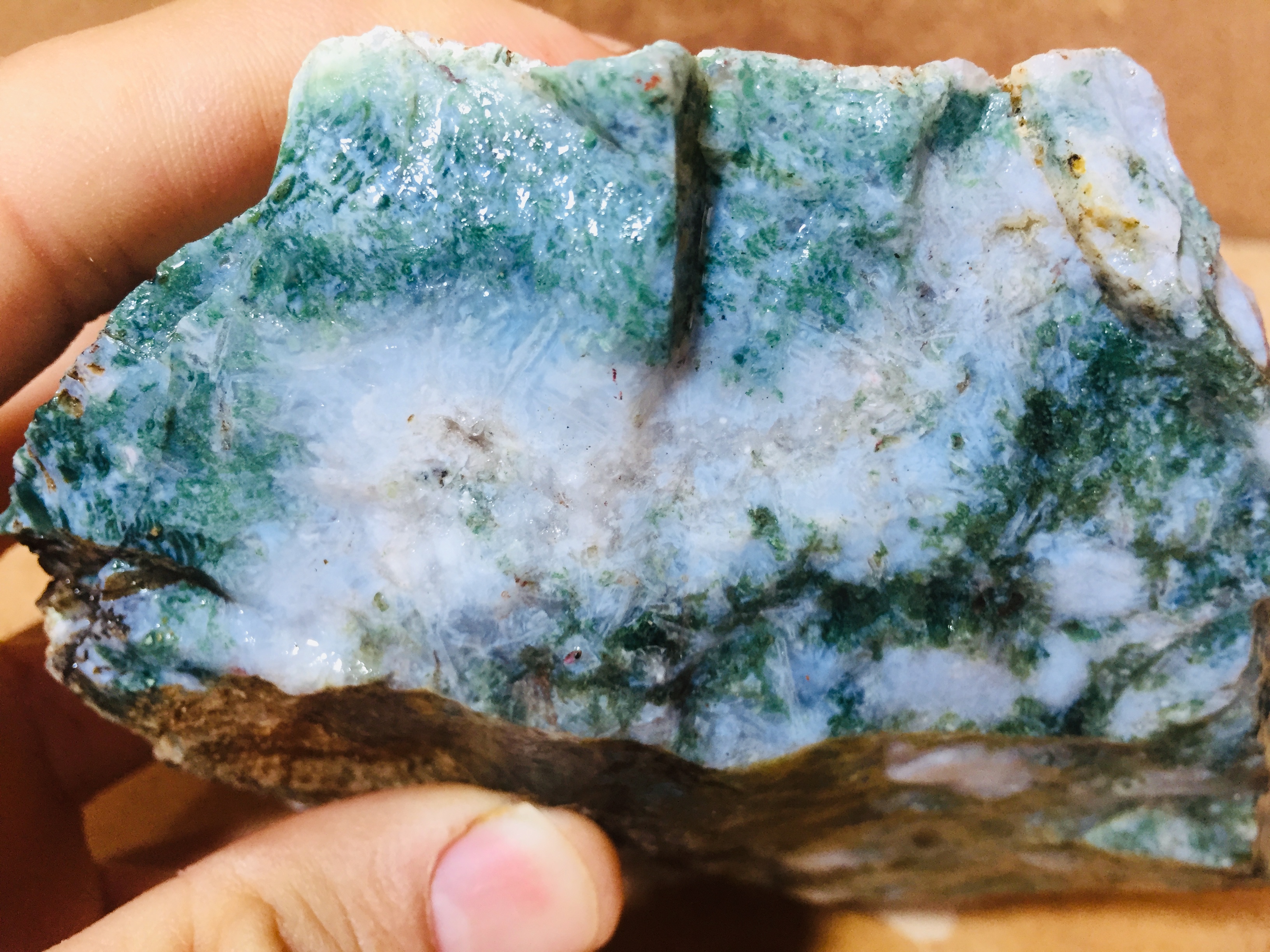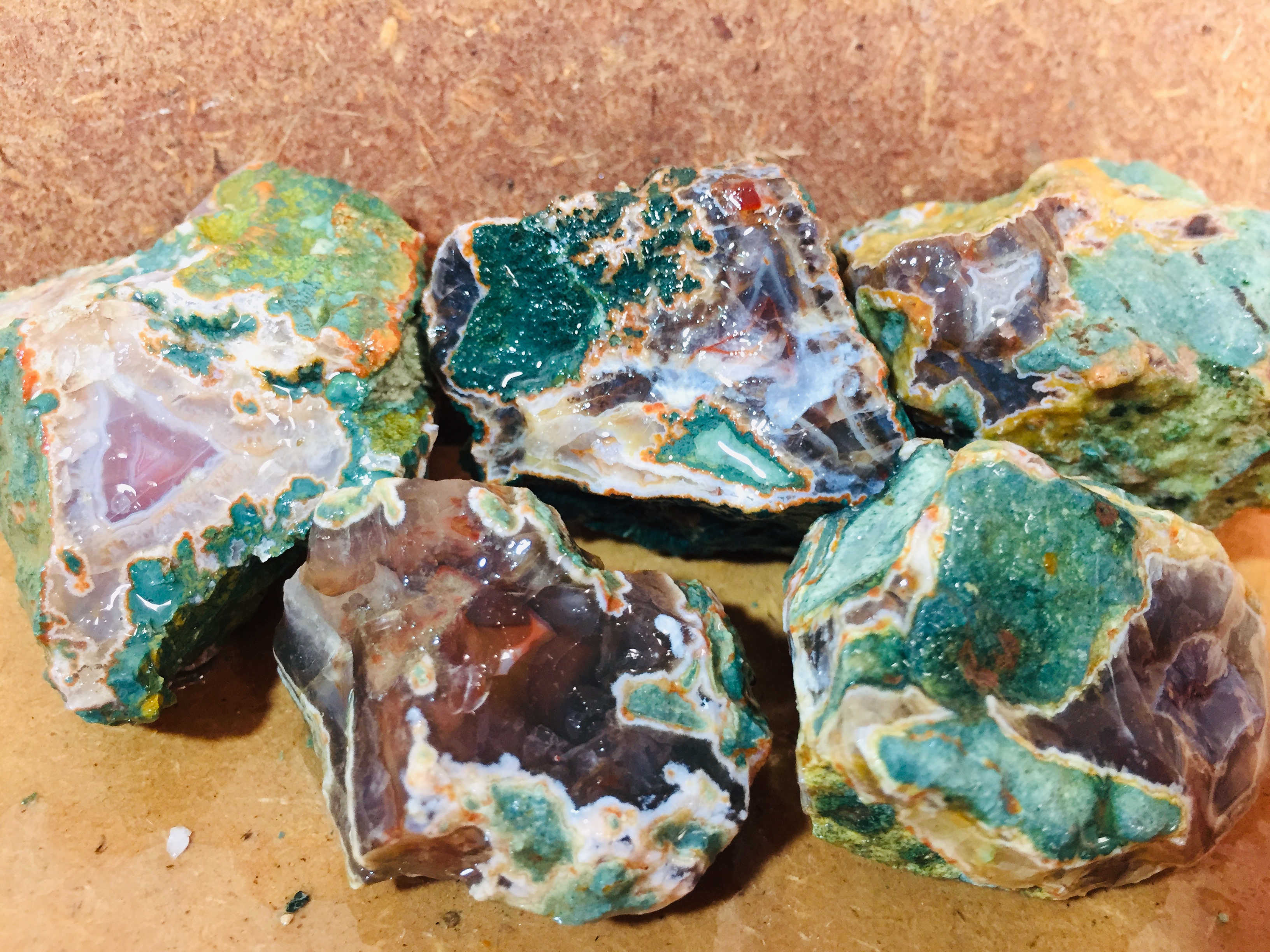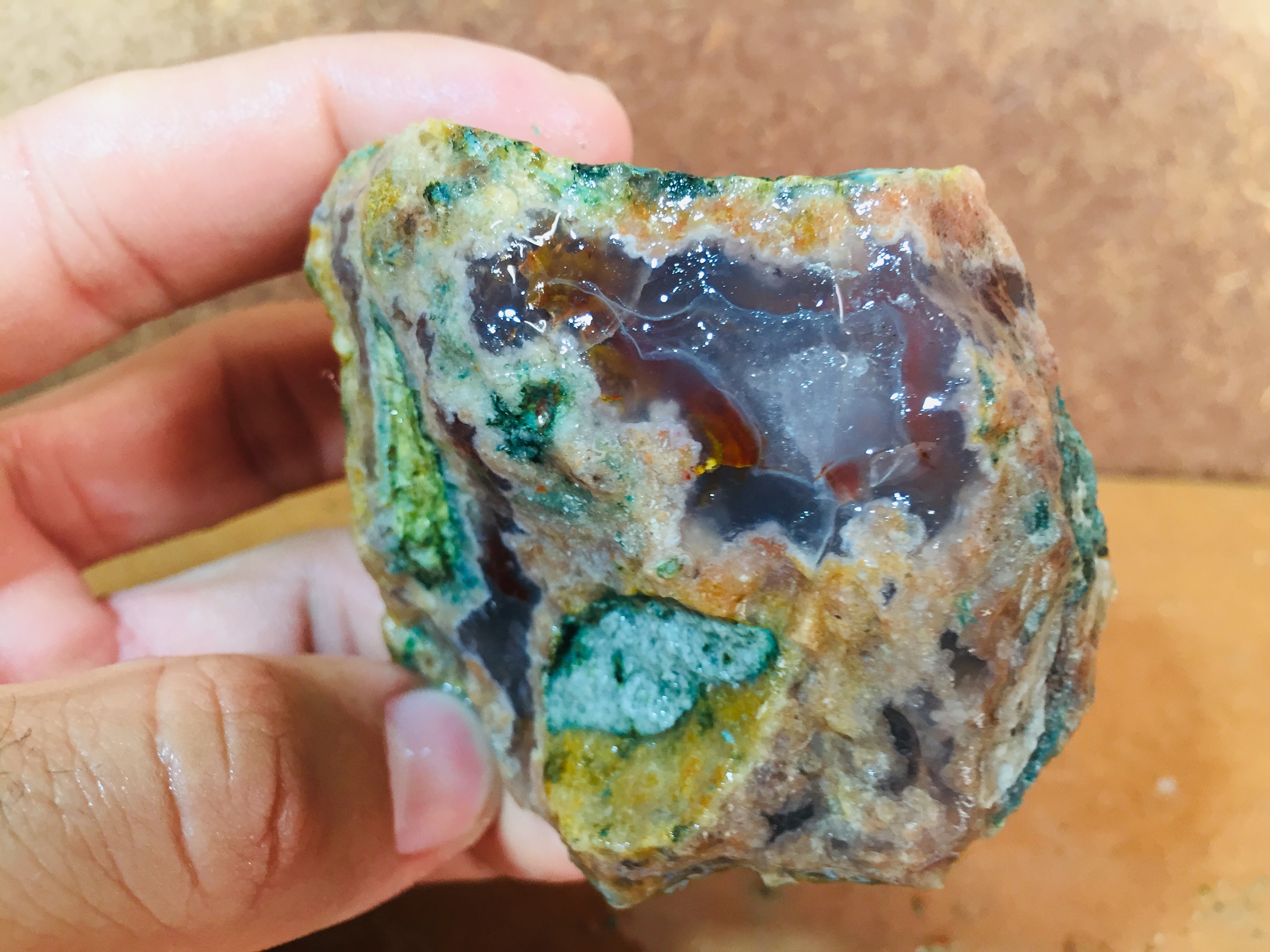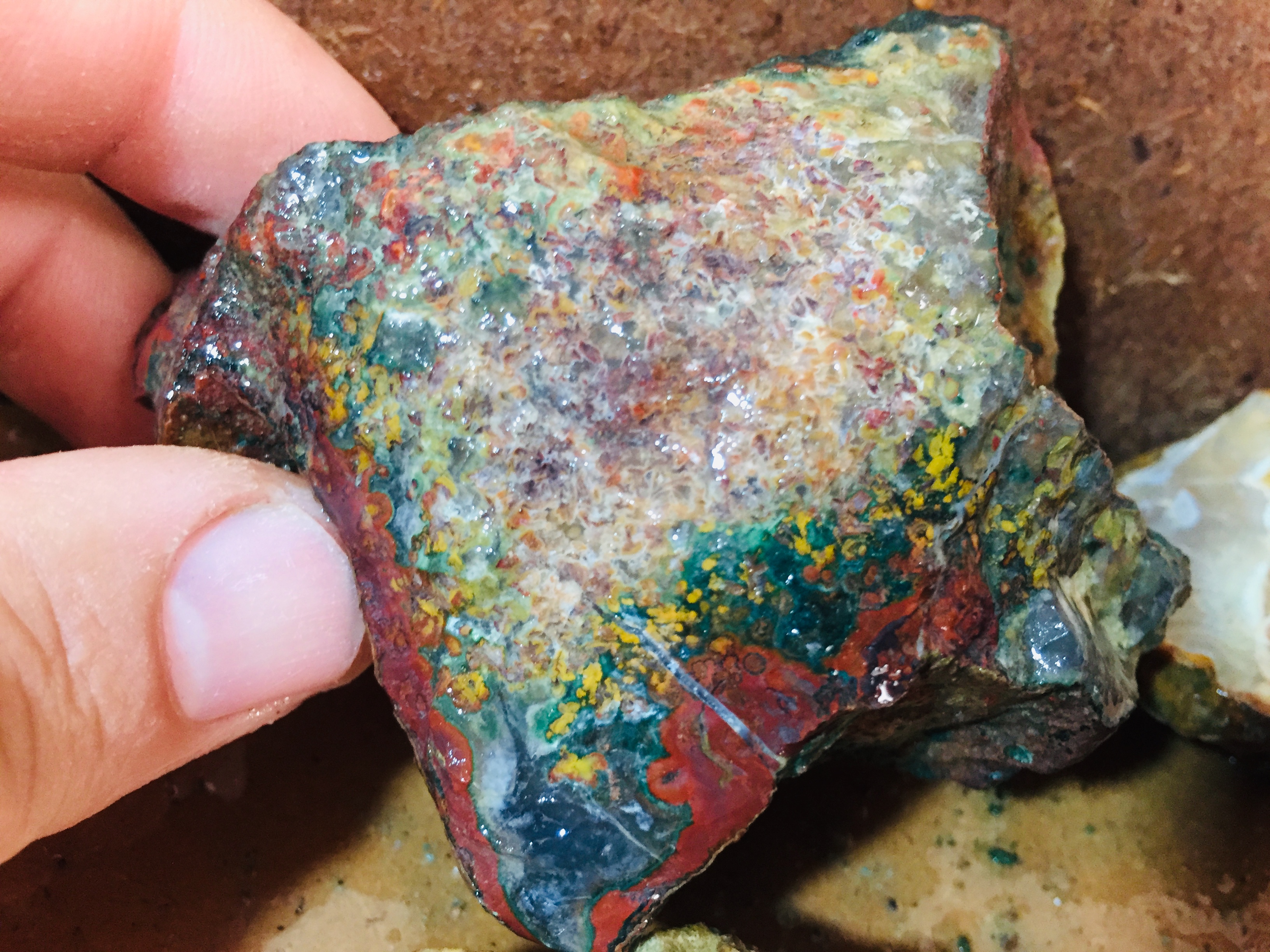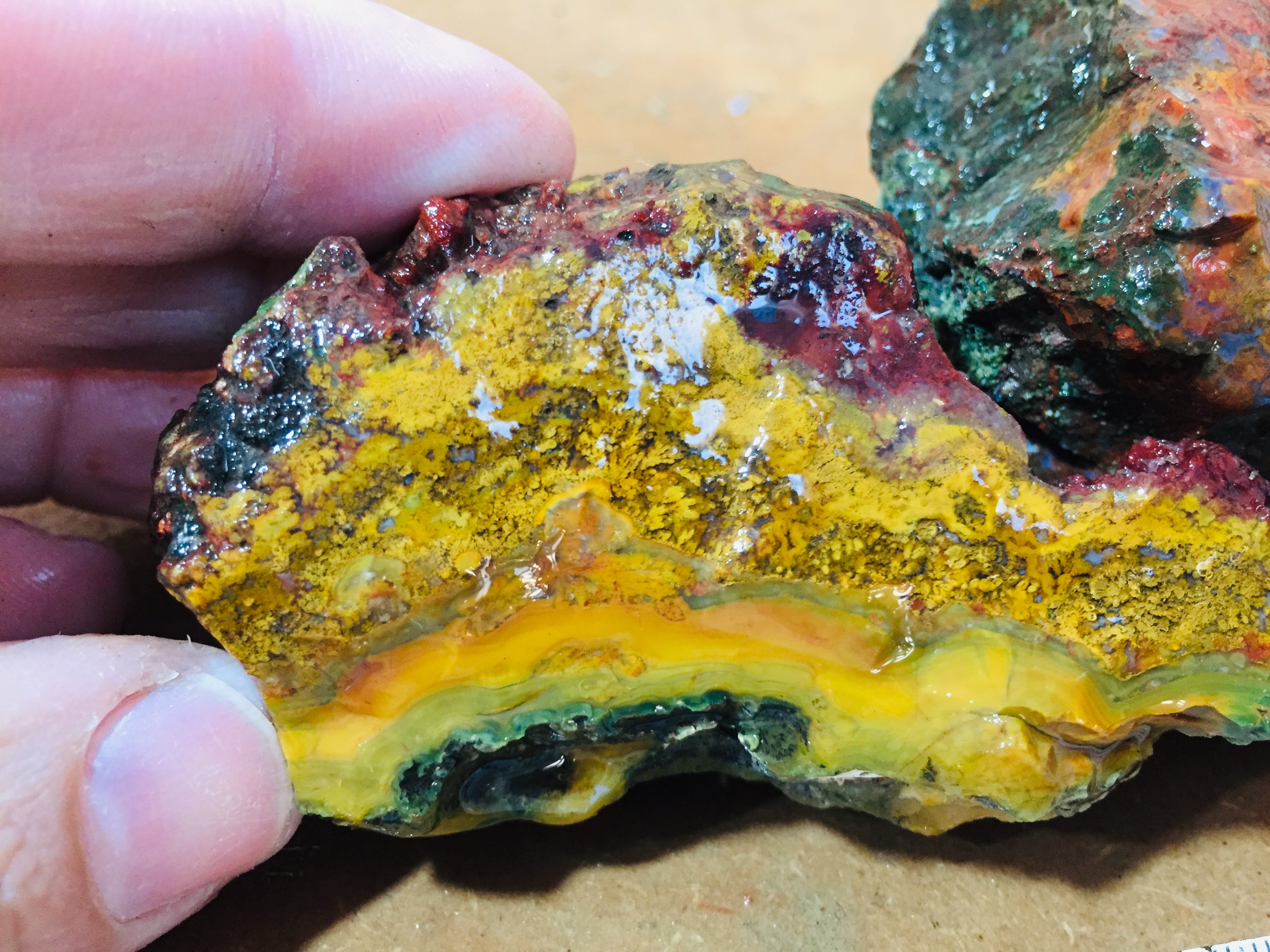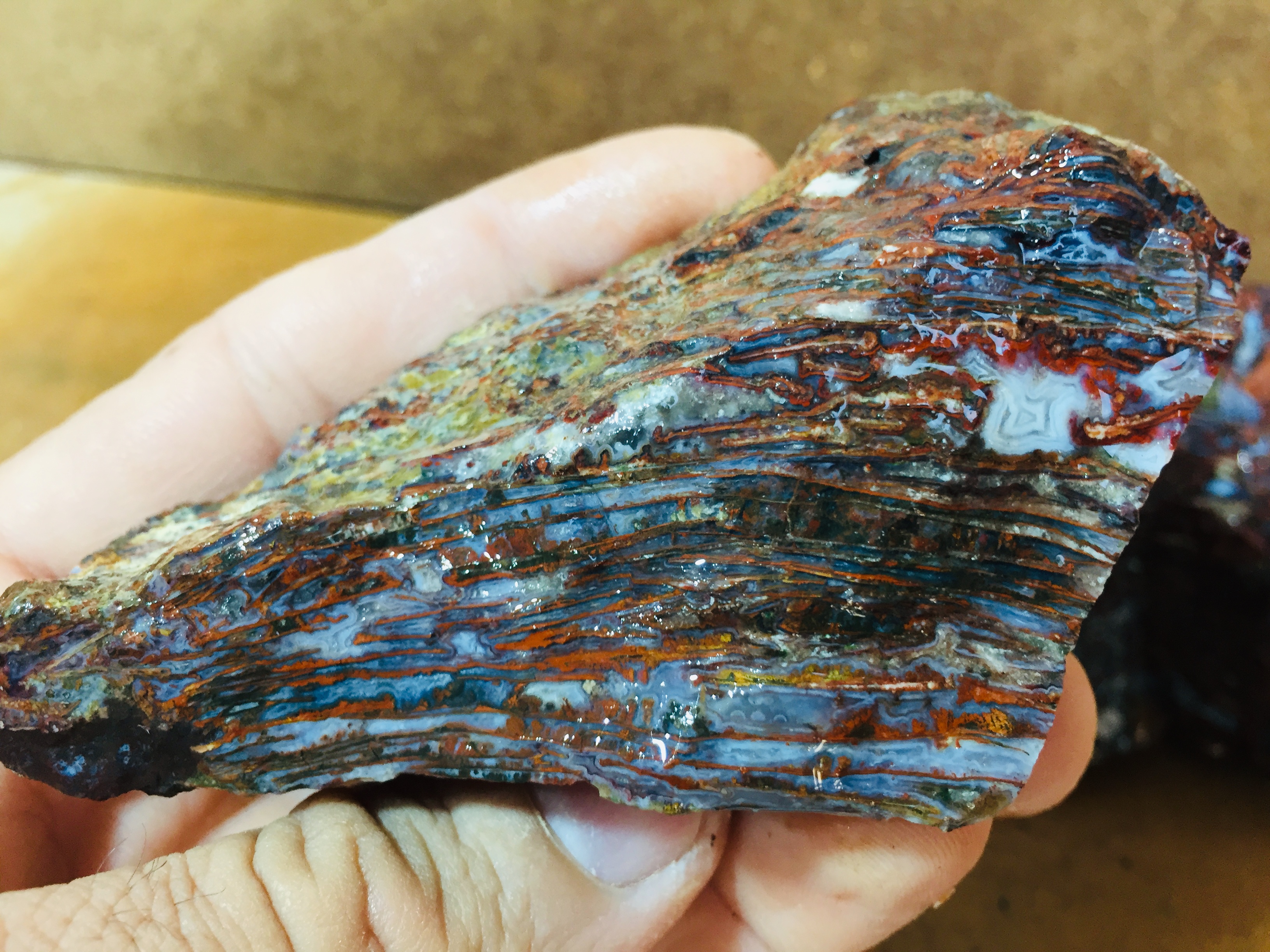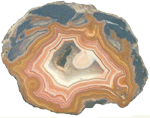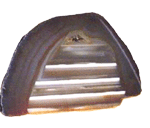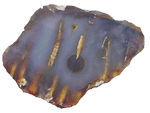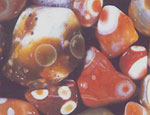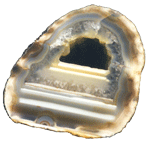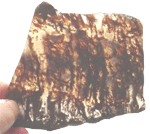Agates are semi-precious gemstones that are a variegated form of
chalcedony (pronounced kal-sed'-nee), which is silicon dioxide in the
form of microscopic fibrous quartz crystals. Agates naturally develop
when an empty pocket inside a host rock fills in molecule-by-molecule,
layer-by-layer as these microcrystals self organize to form concentric
bands or other patterns. The colors and arrangement of the microcrystals
are influenced by changes in pressure, temperature, and mineral content
that occur during the formation process. Unlike other gemstones, each
agate is unique. Even slabs cut from the same specimen will vary in
color and design.
Agates develop as secondary deposits in hollow cavities, called
vesicles. Although they can form in all types of host rock, most of the
world's agates developed in ancient volcanic lava. When the continents
were first forming, layers of molten lava pushed toward the earth's
surface through rift zone cracks, volcanoes, and other geologic events.
Within the lava, there were pockets of trapped gases. Later, these gases
escaped through cracks that formed as the igneous rock cooled and
hardened, leaving hollow cavities. Other cracks and seams also formed
when adjoining sections of lava cooled at different rates.
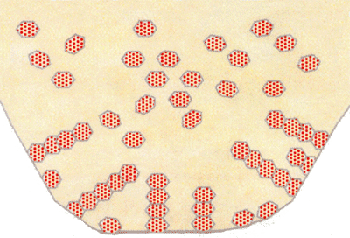
Agate Microcrystal Formation
These empty cavities and seams filled with fluids rich in dissolved
and suspended quartz molecules (silica), as well as other mineral
impurities. When the silica concentration became supersaturated, it
developed a gelatin-like consistency either throughout the pocket or in a
layer that served as the active crystallization front. Over time, the
silica molecules began to form miniature fibrous microcrystals that
attached to the sides of the cavity or seam. During the filling-in
process other mineral impurities collected at the inside of the
chalcedony silica band, forming intervening and often contrasting bands.
This pattern repeated until the entire vesicle was filled in, or until
all the silica rich solution was used up. If there was the proper
balance of silica and mineral impurities, then the entire cavity filled
with alternating bands. If there was an insufficient quantity of mineral
impurity or if the pressures and temperatures changed, the cavity
completed filling in with macrocrystalline quartz, or another form of
silica.
AGATE CHARACTERISTICS
| Physical Properties |
| Composition: |
SiO2 |

A selection of chalcedony agates. |
| Hardness: |
6.5 to 7 |
| Specific Gravity: |
2.4 to 2.7 |
| Refractive Index: |
1.530-1.540 |
| Fracture: |
Conchoidal |
| Crystal Formation: |
Cryptocrystalline |
| Color: |
Varies including gray, blue, yellow, brown, black, white, and green. |
| Translucency: |
Varies from extremely translucent to opaque |
| Streak: |
White |
| Formation Temperature: |
122 to 572 F (50 to 300 C) |
| Tests: |
Insoluble, unless placed in hydrofluoric acid |
| Luster: |
Waxy |
| Porous: |
Yes |
| Melting Point: |
1,600 degrees C (2,912 degrees F)91 |
Types of Agate
There are thousands of named agates found in nearly all countries
of the world. Sometimes agates are named because of their formation
type, such as a fortification agate. In other cases, they are named
after the location in which they are found, such as Brazilian Agate.
Sometimes, it is a combination such as a Brazilian Fortification Agate.
Below are a few examples.
Fortification Agate
This is the most common and distinctive type of agate. In these
agates, bands crystallized into concentric layers that more or less
follow the shape of the cavity. The banding resembles an aerial view of a
fort.
Water-Line Agate (also called water-level or onyx)
During its formation, silica-rich solution either entered the
cavity slowly laying one band at a time, excess water drained out
leaving a small amount of silica to settle out into separate bands, or
the vesicle filled under low pressure. In any case, the silica
crystallization in water-level agates is controlled by gravity in one
orientation, forming a stack up of parallel bands.
Shadow Agate
Some agates exhibit a shadow effect in which there is what
appears to be movement across the agate layers when the specimen is
rocked back and forth (or your orientation to the specimen moves). This
optical effect only occurs when there are alternating translucent and
opaque bands. It is caused when light goes into the agate, but is not
reflected out.
Tube Agate
Tube Agate During the formation of some agates, parallel
projections of tiny hair-thin mineral rods grow first within the silica
gel, around which later the chalcedony agate micro-crystals form. In
some cases the inclusions remain, but sometimes they weather away
leaving hollow tubes that subsequently fill in with silica.
Eye Agates
This mysterious agate characteristic is believed to be formed
when most of the silica gel drains from the cavity, leaving only a
droplet that “beads up” on the inside wall of the cavity. This droplet
crystallizes into solid chalcedony “eyes”. In some cases, crystal growth
will continue from this droplet in a manner similar to the formation of
stalactites in caves. Later, the pocket fills in with the usual
deposition of chalcedony microcrystals.
Plume Agate
These agates initially had formations on their outside layer that
formed prior to the deposition of chalcedony bands. They are filament
growths of mineral inclusions that resemble ferns or feathers.
Geode Agate
Geode Agate In some cases the supply of silica-rich water runs
out before the entire cavity fills in. When there is a hollow center
within a crystalline outer fill, the specimen is considered a geode. Not
all geodes have agate banding, but many do. Also, the inner layers can
form into several different types of silica mineral crystals and may
even have other types of mineral crystals.
Moss Agate
Moss Agate Moss agates have clusters of mineral inclusions that
resemble plants, trees, or landscapes. Most moss agate inclusions are
comprised of iron or manganese oxide. In some cases, the inclusions
inhibit chalcedony banding allowing the mineral clusters free reign to
grow within the silica gel.
Seam Agate
Seam agates for in cracks within host rock, rather than in
rounder pockets. The bands form in parallel rows that follow and fill
in the crack or seam.
HOW TO SEARCH FOR THE ELUSIVE LAKE SUPERIOR AGATE
Although the information below has been compiled to help those in
the upper mid-west to search for Lake Superior agates, the same
information is relative to agates in other locations.
Most Lake Superior agates formed in a rift zone approximately 1.2
billion years ago. Rift zones are cracks in the Earth’s surface out of
which molten lava flowed. Today, there are still rift zones at the
bottom of the Pacific and Atlantic oceans. The rift zone that created
Lake Superior agates started in what is now northeast Kansas and
continued northeast into what is now the western end of Lake Superior.
This hot spot domed up lava several miles high and eventually choked
itself off. If it would have continued, it could have split the North
American continent in half.
It was in the steam-vacated pockets in this lava that agates
formed. Later, as erosion and glaciers broke apart this igneous rock,
the forces of nature spread the freed up agates throughout the upper
mid-west. The primary area of Lake Superior agate distribution is shown
below.
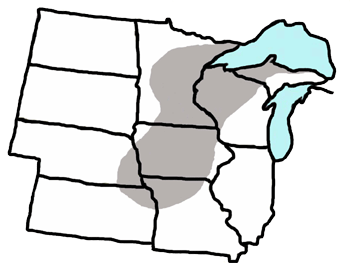
Primary Lake Superior Agate Search Area
The list below provides some basic information to help you find
the elusive Lake Superior agate. If you are interested in more detail,
please visit the Gitche Gumee Museum and request an agate class, or visit the on-line gift shop to purchase the museum’s book "Understanding and Finding Agates".
- Scan the beach and look for the Iron oxide red color.
- Look for rocks that show evident concentric banding.
- Check for possible entrance and/or escape channels that
allowed gases or originally escape from the cavity, silica-rich water to
enter, and pressure formed during the agate precipitation process to
escape.
- Search for rocks with conchoidal fractures that give the specimen a more angular, irregular shape.
- Look for the pit-marked surface that is either a mold of the
rough-textured igneous material of the host rock in which the agate
formed, or the pits left from softer minerals that originally lined the
cavity but subsequently eroded away.
- Look for any pseudo-bands that exhibit possible structure or
banding on the inside of the agate that is not immediately evident on
the outside.
- Examine the conchoidal fractures to see if they expose any
“windows” to the interior of the rock that indicate that there may be
something different on the inside.
- Use the sun or a flashlight to backlight the specimen. Check
for translucency as well as any banding that may not be visible without
backlighting.
- Scan the rock piles for specimens that have a waxy, gray, chalcedony luster.
- When the angle of sun is low on the horizon, walk toward the
sun and look a distance in front of you to look for the extremely
translucent red carnelian agates.
- Look for seam agates as well as nodular agates. In both
cases, there should be evidence that silica microcrystals precipitated
out of solution to fill the agate one molecule and one layer at a time.
- Look for moss agates (growths of mineral inclusions imbedded in a translucent chalcedony).
- Keep a look out for water-line agates with stacked up horizontal layers.
- Be aware of the “agate-want-a-bees”:
- Metamorphic rocks -- Many of these specimens have old
sedimentary layers or loose striated patterns of minerals that lined up
by density under the intense heat or pressure of metamorphism.
- Chert, Jasper, and Flint -- These chemical first
cousins are silica dioxide minerals, but not considered agate. They are
always opaque because their microcrystals are granular and packed closer
together than the fibrous structure of chalcedony. Like agate, though,
can be banded with conchoidal fractures.
- Secondary Fills -- Rocks in which a crack filled in with
another mineral all in one shot, like fluid being forced through a soda
straw. The seam or crack in the rock could have agatized, but didn’t.
- Fossils -- Some fossils appear to show banding or
structure, but instead formed when silica dioxide molecules replaced
organic cells. Notice that in some silica fossils, light will shine
randomly from the surfaces of larger macro crystals.
METAPHYSICAL PROPERTIES OF AGATE
People for thousands of years have believed that agates have
metaphysical properties that enhance life and prevent or help cure all
sorts of disorders. Some think that agates provide for balancing your
physical, emotional, intellectual, and spiritual energies. Others report
that agates stabilize and cleanse your aura and act to smooth
dysfunctional energies and transform or eliminate negativity. A partial
list of reported agate capabilities is below.
- Prevents insomnia
- Promotes pleasant dreams
- Makes you more persuasive
- Helps you to be less disagreeable
- Helps cure skin diseases
- Protects from danger
- Promotes good agricultural crops
- Diverts dangerous storms
- Helps predict the future
- Keeps the blood healthy
- Relieves thirst
- Helps you to be truthful
|
- Encourages a broader perspective
- Attracts good fortune
- Increases concentration
- Promotes good will
- Is an aid in overcoming flaws
- Helps eliminate bad luck
- Calms fear and stress
- Provides a sense of strength and courage
- Stimulates fertility
- Helps bone marrow
- Relieves allergies
- Enhances creativity
|
NOTE: Scientific proof is not available to verify the metaphysical properties listed above.
Return to Top of Menu
GITCHE GUMEE GEOLOGY
Introduction
Geology deals with both the nature and history of the earth.
When you study geology, you ask questions such as: How old is the earth?
How and where did the materials that compose the earth originate? How
did the surface landforms come into being?
Rocks and minerals and the processes that created them are the
essence of planet earth, and in understanding them you can better
understand us as well as our relationship with the earth. Without
geology, many of the things we take for granted would not have been
built, assembled, or invented.
Many North American Indians believe that we have a special
relationship with planet earth. To them, the earth is family. We have a
sacred responsibility to the planet and to all creatures that live upon
her. We are all part of the circle, all part of Mother Earth. They
believe we are charged with the sacred duty: we are the keepers of the
earth. It is this special relationship with planet earth that
provides the basis for many of the Native Americans’ beliefs, and much
of their culture and science. It is this relationship that also defines
their ideas and practices on how to use and manage our natural
resources.
In the Beginning – 4.6 billion years ago
Picture the earth’s surface, as it existed in the beginning,
pockmarked by impacts by large and small meteorites. No atmosphere or
oceans were present. The earth consisted of a random mixture of
meteorites accumulated when it formed 4.6 billion years ago. Then, as
the earth gradually heated inside from the decay of radioactive
elements, the interior reached the melting temperature of the rocks.
This ushered in the most spectacular display of volcanic activity in
earth’s history, which formed the shields that served as the foundation
of today’s continents.
| Precambrian “shields” of the world (in black) with
associated stable regions (horizontal rule). These bedrock shields are
ancient and complex consisting mainly of igneous and metamorphic rock
types. |
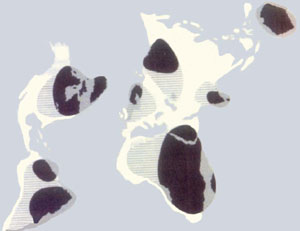 |
Early Precambrian (4.6 to 2.5 billion years ago)
At somewhere around 4 billion years ago we can picture the Lake
Superior region as a vast expanse of lifeless ocean with chains of
volcanic islands, similar to the present-day Aleutian Islands. Once
these islands extended above the surface of the primordial ocean, waves
began to beat against the rocks. Since erosion was rapid and the ocean
bottom dropped off rather steeply, sediments had little chance to
undergo chemical weathering or sorting. This process was repeated over
and over again resulting in the formation of thick sequences of
monotonously uniform sediments called greywackes.
Most of the mineral wealth in the Lake Superior Basin is found in
Precambrian rocks. The deposits include gold, silver, copper, zinc,
lead, nickel, cobalt, and iron.
Late Precambrian (Proterozoic)—2.4 billion to 600 million years ago
The Early Proterozoic period lasted 800 million years (2.4 to 1.6
billion years ago). Geologists have concluded that the Lake Superior
basin during much of this period was similar to the present day Persian
Gulf. The major events of this period included:
- Gradual rifting and break up of a large continent assembled during the early Precambrian period.
- A change to convergent plate motion (plates moving toward
each other) wherein one plate was subducted under the other. This
caused the development of a volcanic island arc over the subduction zone
somewhere offshore from the Superior continent.
- As the plate convergence continued there was then a collision
of the island arc with the Superior continent about 1.86 billion years
ago. This created the Penokean Mountain range across what is today the
Lake Superior basin. This range is comparable to the present day
Appalachian Mountains, but probably was as high as the present Rockies.
The mountain range extended from northeastern Iowa eastward across
Wisconsin, Michigan, and southern Ontario.
- This range was subject to erosion during most of the Middle
Proterozoic time. The erosion that erased the Penokean Mountains
continued for at least 500 million years, gradually reducing the lofty
mountains.
- Next, there was another period of volcanic activity. As lava
spilled out of the rift zone, gas bubbles rose slowly through the lava
producing tubes. Some of these vesicles later filled in with various
substances. The filling of these cavities with silica-rich water, for
example, formed Lake Superior agates. The spreading in the rift zone
continued for approximately 150 million years. At the conclusion of the
rifting period, the Lake Superior region was somewhat like the present
east coast of North America.
- Volcanism ended about 1.084 billion years ago and the great
pool of basaltic magma began to cool. The weight of the immense pile of
lava flows and cooling at the base of the crust resulted in continued
subsidence along the rift. Streams flowing into the subsiding basins
eroded the volcanic landscape and deposited thousands of feet of red
sandstones and conglomerates on alluvial fans. Sands, silts, and mud
deposited in lakes that occupied the central part of the rift zone.
Paleozoic Period (600 to 220 million years ago)
The Paleozoic Era contained several different periods including
the Cambrian, Ordovician, Silurian, Devonian, Mississippian,
Pennsylvanian, and Permian periods.
During the Cambrian period (about 570 million years ago) the
North American continent was nearly the size it is now and was mainly
above sea level. Then either the continents began to sink or the sea
level began to rise, because the seas slowly spread out over the land
surface. It took nearly 100 million years for the seas to reach the
Lake Superior region. Waves, pounding on the shores of that sea,
shifted the particles of sand back and forth along the beach, rounding
them to nearly perfect spheres.
These seas were different than all previous seas. For the first
time in the geologic record, the seas contained abundant animal and
plant life. Skeletons and other remains of these organisms attest to
their presence. Fossil remains of these organisms are helpful in
reconstructing environments and are invaluable for correlating rock
sequences from one area to another. Over the long period of crustal
stability and erosion during the last 400 to 500 million years of
Precambrian time, the earth’s atmosphere became sufficiently oxygen
bearing for animal life to evolve. The fossil record for practically
all of Precambrian time indicates that the forms of life on earth were
almost entirely plants (algae) and bacteria. Then, in a short period of
time at the beginning of the Paleozoic, there was an evolutionary burst
of life unlike anything before or since.
The most abundant animals of the Cambrian seas were the
trilobites, a type of Crustacean and a biologically complex organism.
They were so numerous and diverse that they constituted nearly 60
percent of the varieties of Cambrian life. They ranged in size from
less than an inch to more than 20 inches long weighing up to ten pounds.
They dominated life in the Cambrian seas for over 100 million years.
Like the Cambrian and Ordovician, the Silurian had its own distinctive
group of fossils. Also like the Cambrian and Ordovician, nearly all the
fossils found in central North America are of animals that flourished
in warm tropical seas. It is generally accepted that plate tectonic
motions during the Paleozoic period places the Lake Superior region land
along the equator.
During the Silurian, corals took over as the dominant species.
During the Devonian, fish developed as the dominant species.
(Age of the fishes). Another change during the Devonian was the first
evidence of a significant number of land plants. By 360 million years
ago, lowland forests with trees up to 30 feet tall were present. While
the trees and other plants were different than those of today, they made
a profound change in a landscape that had stood naked for over 4
billion years except for probably lichens and algae coatings on the
rocks. As hardier varieties of plants evolved, the entire land surface
was covered and in the following periods vast swamplands covering much
of North America stood for millions of years.
During the Devonian, fish developed as the dominant species.
(Age of the fishes). Another change during the Devonian was the first
evidence of a significant number of land plants. By 360 million years
ago, lowland forests with trees up to 30 feet tall were present. While
the trees and other plants were different than those of today, they made
a profound change in a landscape that had stood nearly naked for over 4
billion years. Previously, only lichens and algae coated the rocks. As
hardier varieties of plants evolved, the entire land surface was
covered, including vast swamplands that stood for millions of years.
The spreading of plants over the land was followed closely by
air-breathing amphibians. With the development of lungs, animals had a
vast new array of environments to inhabit. During the next 100 million
years, a great variety of land animals evolved, including amphibians,
reptiles, and innumerable insects.
With the evolution of land plants and animals the surface of the
land changed forever. Plants helped to hold the soil on slopes,
retarding erosion, yet decay of plant materials provided various humic
acids that promoted chemical weathering of soils.
Mesozoic (220 to 63 million years ago)
During this era, there were three main periods: Triassic,
Jurassic, and Cretaceous. This was the era wherein life continued to
evolve and explode on earth. Other than significant contributions to
the fossil record including the fabulous evolution of dinosaurs, there
were not many significant geologic events during this period.
Cenozoic (63 million years ago to present)
The Cenozoic era comprised the Tertiary and Quaternary periods.
The only geologically significant event during this era was the
Pleistocene Ice Age, which occurred between 2 million and 8,000 years
ago. This final chapter of the geologic history of the Lake Superior
region was different from all the preceding events. Several times
during the Pleistocene, huge masses of glacial ice many thousand feet
thick (some geologists estimate up to 10,000 feet) covered most of the
northern half of North America. The glaciers scraped and removed most
of the weathered rock that had been accumulating north of the Great
Lakes since the withdrawal of the Paleozoic seas some 270 million years
earlier. Much of this debris was carried southward, and when the ice
melted, was deposited in lower Michigan, Illinois, Wisconsin, Iowa, and
southern Minnesota. The combination of glacial erosion and deposition
greatly altered the landscape filling some valleys, deepening others and
in general modifying the previous drainage patterns. The Great Lakes
were formed by glacial erosion, as were many other lakes.
| General locations of the boundaries of the Pleistocene ice sheet. |
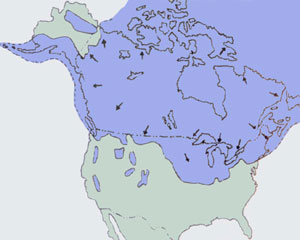 |
When the developing sheets of ice from neighboring valleys met
and coalesced with each other, this union formed more extensive areas of
ice the gradually deepened, eventually burying the hills on which the
ice originally accumulated. During the Pleistocene, as much as 30
percent of the earth’s land surface was covered by glaciers, compared
with about 10 percent today. It is estimated that up to 8 percent of
all the earth’s water was tied up in glacial ice during the Pleistocene,
compared with about 3 percent today. There were two main consequences:
(1) It lowered sea level several hundred feet, exposing large areas of
the sea floor along the present coastlines; (2) The weight of this ice
on the land surface depressed the crust locally as much as 2,000 feet
from its normal position.
When the ice reached the Lake Superior region, it was diverted
into the major stream valleys, where it advanced as great tongues or
lobes. The channeling of ice coupled with the soft underlying bedrock
resulted in much erosion in these valleys, deepening them hundreds of
feet. Thus, Lake Superior is over 1,300 feet deep and Lake Michigan
more than 900 feet deep.
After being weighted down by glaciation, the Upper Peninsula is
rebounding between .3 and 6 cm per 100 years. Sault Ste Marie, for
example, has rebounded 180 feet in the past 6,000 years.
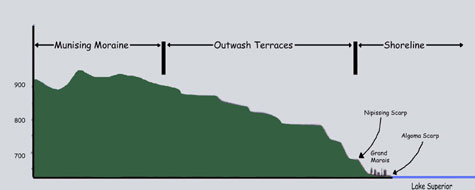
Terrain Detail of Grand Marais
Conclusion
Many Native Americans conceive of time, history, and
relationships with the land as a circle, and the circle has come to
symbolize a continent-wide philosophy. Every thought and action in
Indian life has repercussions in the natural world, and every event in
the natural world, every unusual phenomenon has deep significance to
human lives. If we show respect for Mother Earth -- she will show
respect for us.
The Irokwa Indians of the northeast believe that one must always
consider the results of their deeds on the seventh generation after
their own. Maybe those of us who are living in the 21st century can
learn something from this.
It would be much better and healthier for us, and for planet
earth, if we all saw with two eyes instead of one. I believe we should
adopt a holistic approach to planet earth. With cooperation, proper
perspective, and planet-focused respect, we may preserve our planet on
an even keel, develop improved political balance, and keep us humble,
respectful, caring, and smiling.
Copyright
- 2016
All rights reserved.
Gitche Gumee Museum.
E21739 Brazel Street
Grand Marais, Michigan 49839
Source
http://www.agatelady.com/agate-basics.html

